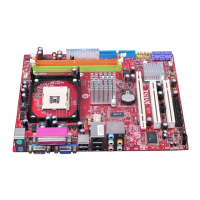11
Setting to [Auto] enables DRAM CAS# Latency automatically to be determined by BIOS
based on the configurations on the SPD (Serial Presence Detect) EEPROM on the DRAM
module.
Advance DRAM Configuration > CAS Latency (CL)
When the DRAM Timing Mode sets to [Manual], the field is adjustable. This controls the
CAS latency, which determines the timing delay (in clock cycles) before SDRAM starts a
read command after receiving it.
Advance DRAM Configuration > tRCD
When the DRAM Timing Mode sets to [Manual], the field is adjustable. When DRAM is
refreshed, both rows and columns are addressed separately. This setup item allows you to
determine the timing of the transition from RAS (row address strobe) to CAS (column
address strobe). The less the clock cycles, the faster the DRAM performance.
Advance DRAM Configuration > tRP
When the DRAM Timing Mode sets to [Manual], this field is adjustable. This setting controls
the number of cycles for Row Address Strobe (RAS) to be allowed to precharge. If
insufficient time is allowed for the RAS to accumulate its charge before DRAM refresh,
refresh may be incomplete and DRAM may fail to retain data. This item applies only when
synchronous DRAM is installed in the system.
Advance DRAM Configuration > tRAS
When the DRAM Timing Mode sets to [Manual], this field is adjustable. This setting
determines the time RAS takes to read from and write to memory cell.
FSB/ DRAM Ratio
This setting controls the ratio of CPU FSB Clock & DRAM Frequency to enable the CPU &
DRAM to run at different frequency combinations (non-synchronous overclocking). Please
note that the setting options vary according to the CPU FSB Clock preset.
Auto Disable DIMM/ PCI Frequency
When set to [Enabled], the system will remove (turn off) clocks from empty DIMM and PCI
slots to minimize the electromagnetic interference (EMI).
Spread Spectrum
When the motherboard’s clock generator pulses, the extreme values (spikes) of the pulses
creates EMI (Electromagnetic Interference). The Spread Spectrum function reduces the EMI
generated by modulating the pulses so that the spikes of the pulses are reduced to flatter
curves. If you do not have any EMI problem, leave the setting at Disabled for optimal system
stability and performance. But if you are plagued by EMI, set to Enabled for EMI reduction.
Remember to disable Spread Spectrum if you are overclocking because even a slight jitter
can introduce a temporary boost in clock speed which may just cause your overclocked
processor to lock up.
Important:
If you do not have any EMI problem, leave the setting at [Disabled] for optimal system
stability and performance. But if you are plagued by EMI, select the value of Spread
Spectrum for EMI reduction.
The greater the Spread Spectrum value is, the greater the EMI is reduced, and the system
will become less stable. For the most suitable Spread Spectrum value, please consult your
local EMI regulation.
Remember to disable Spread Spectrum if you are overclocking because even a slight jitter
can introduce a temporary boost in clock speed which may just cause your overclocked
processor to lock up.
PDF created with pdfFactory Pro trial version www.pdffactory.com

